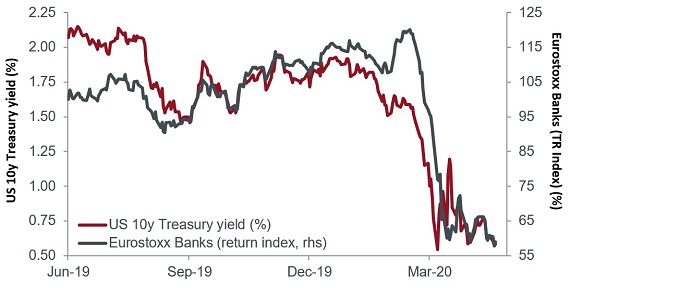Subscribe
Sign up for timely perspectives delivered to your inbox.
Paul O’Connor, Head of the UK-based Multi-Asset Team, considers the prospects for equities and other risk assets, as negative oil prices put the brakes on the recent v-shaped market recovery.
Key takeaways
This week’s hair-raising price action in the oil market seems to have put the brakes on the month-old rally in equities and other risk assets. While battle-hardened investors have come to terms with many unusual and unprecedented market phenomena in recent weeks, negative oil prices appear to have been just one novelty too many, for now. Still, Monday’s plunge in the May contract of WTI[1], to an intraday low below -US$40 per barrel, was probably as good a time as any for investors to take a pause for thought, after a V-shaped recovery in risk assets.
Coming into this week, the world’s major equity markets had rallied by over 26% from the March lows, recovering 50% of the preceding sell-off[2]. Technical analysts see this sort of retracement as being just when rallies would typically meet resistance and uptrends level off into range trading consolidation phases. We see fundamental reasons to come to the same conclusion. In broad terms, we believe that the factors that drove the market rebound are now well understood and priced in, and the relative strength of positive and negative market themes are now fairly well balanced.
While improving news on both the policy and the coronavirus fronts propelled markets out of the deep gloom of mid-March, we believe that the next major battle for market sentiment will be fought over the outlook for the world economy in the second half of the year. One cautious view that must be respected here is that investors have very little visibility on this outlook right now, given the uncertainty surrounding the coronavirus and the economic restrictions associated with it. The continued slide in consensus estimates of economic growth and corporate earnings suggests that neither economists nor equity analysts have yet fully factored in the scale of the COVID-19 slump.
Although much of the recent volatility in the oil market reflects industry-specific supply concerns, it also reflects significant demand uncertainty. It is worth noting that weakness in cyclical commodity prices is not just an oil story — the Commodity Research Bureau (CRB)’s Raw Industrials Index is also making a new low. This is a broad index of raw materials that are not futures traded, so it tends to reflect real industrial demand, free from speculative market noise. The continued softening in growth expectations remains a global phenomenon and one that is evident in most sectors of the economy. This theme is also clearly expressed in government bond markets, where inflation expectations remain weak and where US 10-year treasury yields are only a few basis points above March’s all-time low. Exhibit 1 shows how this theme has been reflected in the synchronised movement between different areas of the market.
 Source: Bloomberg, Janus Henderson Investors, 3 June 2019 to 22 April 2020.
Source: Bloomberg, Janus Henderson Investors, 3 June 2019 to 22 April 2020.
Note: EURO STOXX Banks Index EUR index rebased to 100 at start date. Generic 10‑year US government bond yields. Yields may vary and are not guaranteed. Past performance is not a guide to future performance.
While forceful monetary and fiscal intervention and a belief that the first wave of the pandemic is peaking have fuelled a strong rebound in risk assets in recent weeks, we would be wary of extrapolating the uptrend too much further for now. These positive themes have now gained widespread acceptance, which means that their ability to influence financial markets is likely to be fading. Accordingly, we believe that a period of market consolidation is more likely from here, than a continued strong rally in risk assets. While cautious investor positioning and the extraordinary liquidity support from central banks should help limit the downside in risk assets, meaningful upside will probably require greater conviction in the strength of the global recovery in the second half of the year. This may take some time to emerge.
[1] US West Texas Intermediate crude oil
[2] MSCI World Index (USD), total return, 23 March 2020 to 17 April 2020.